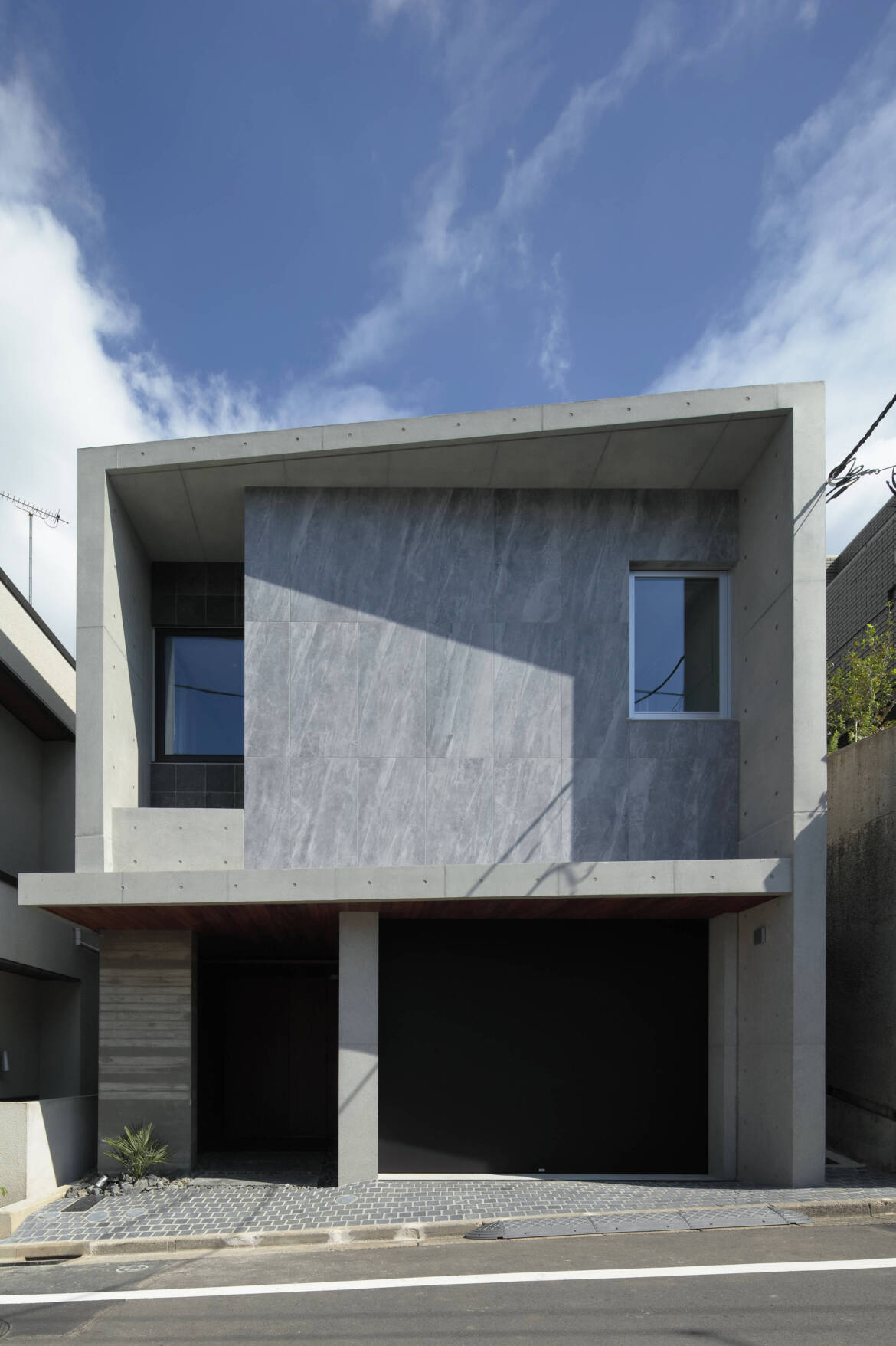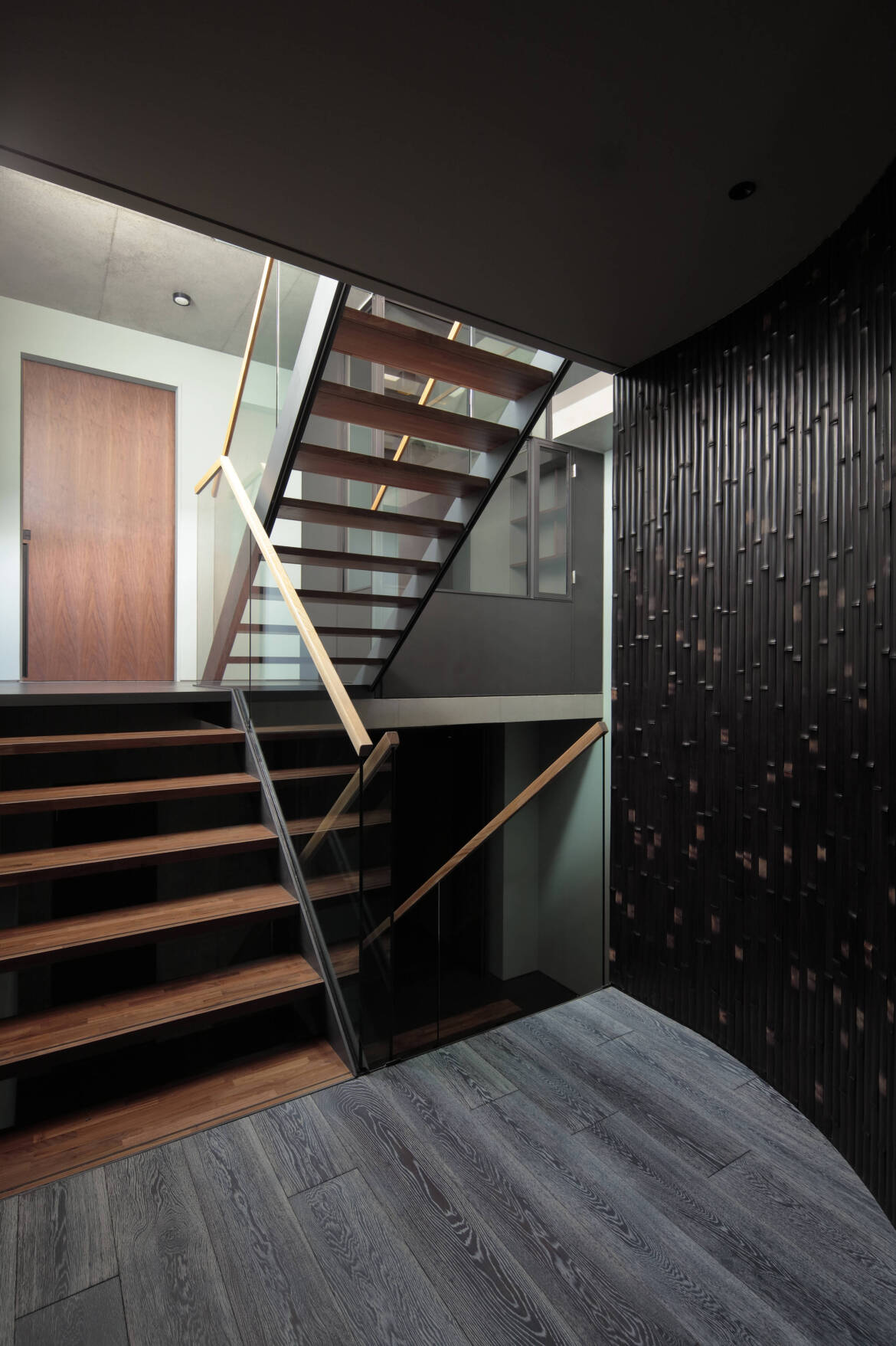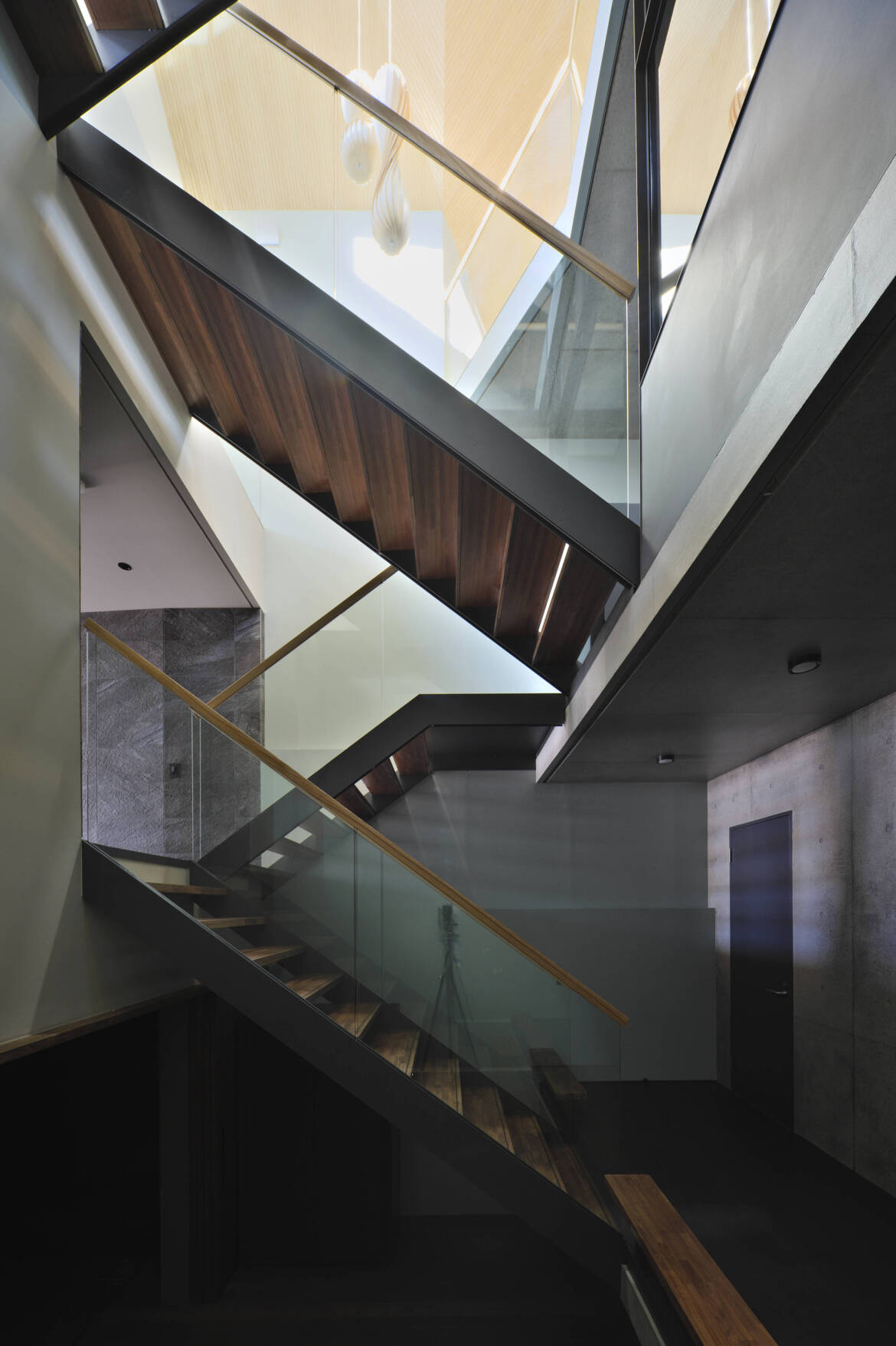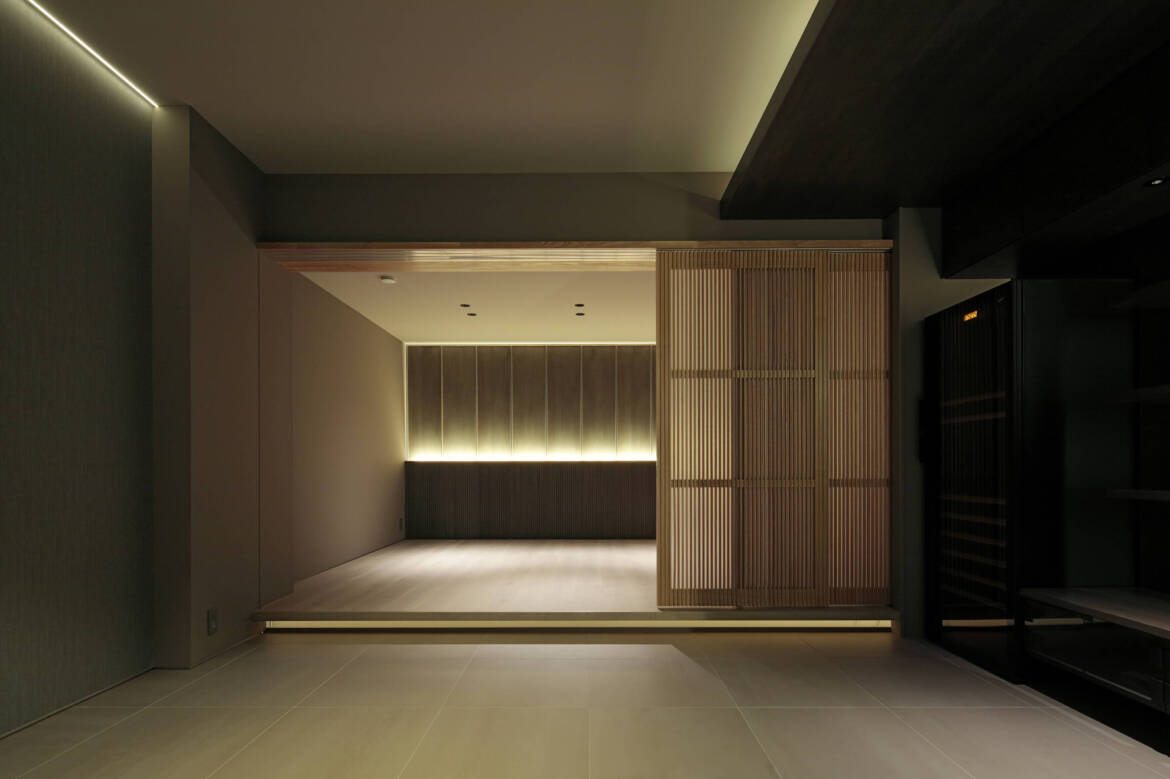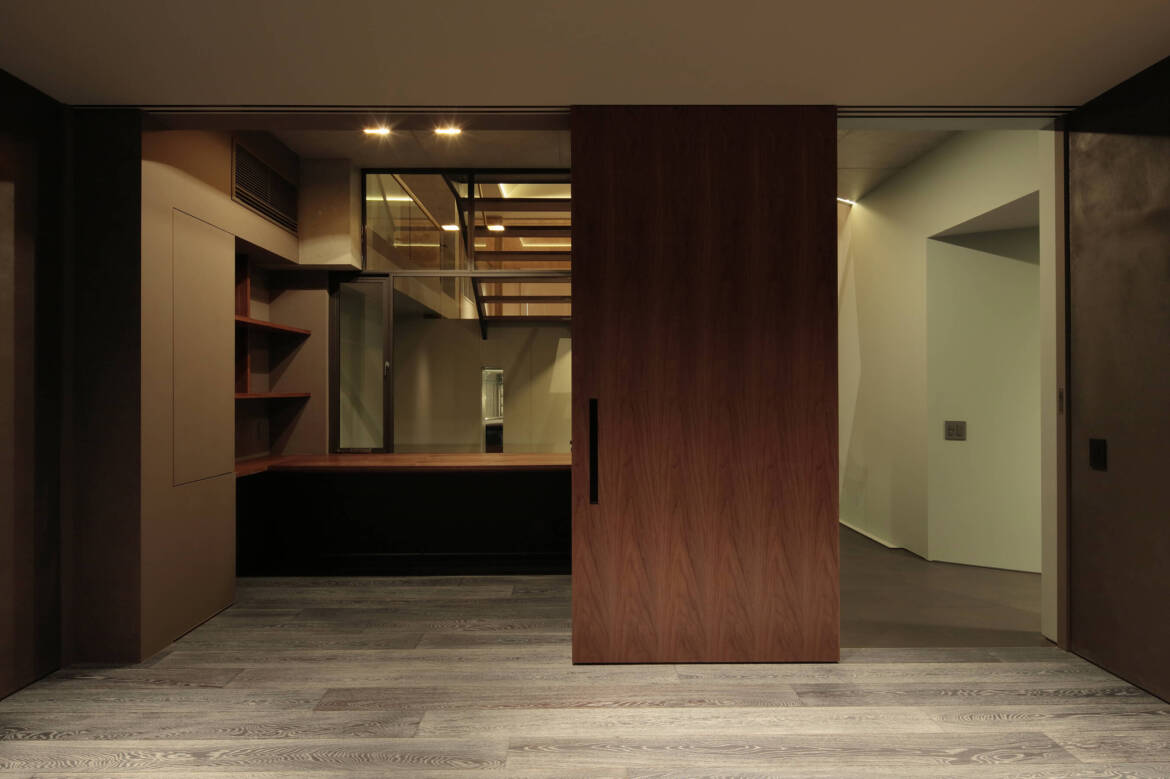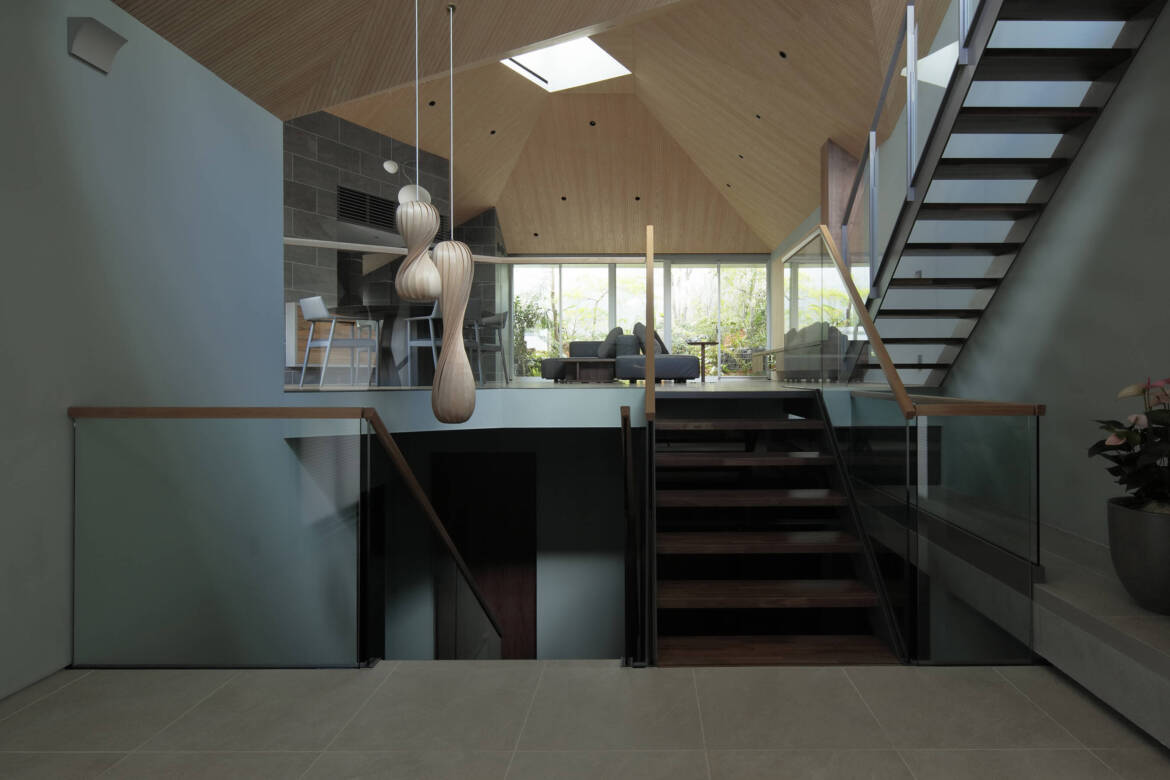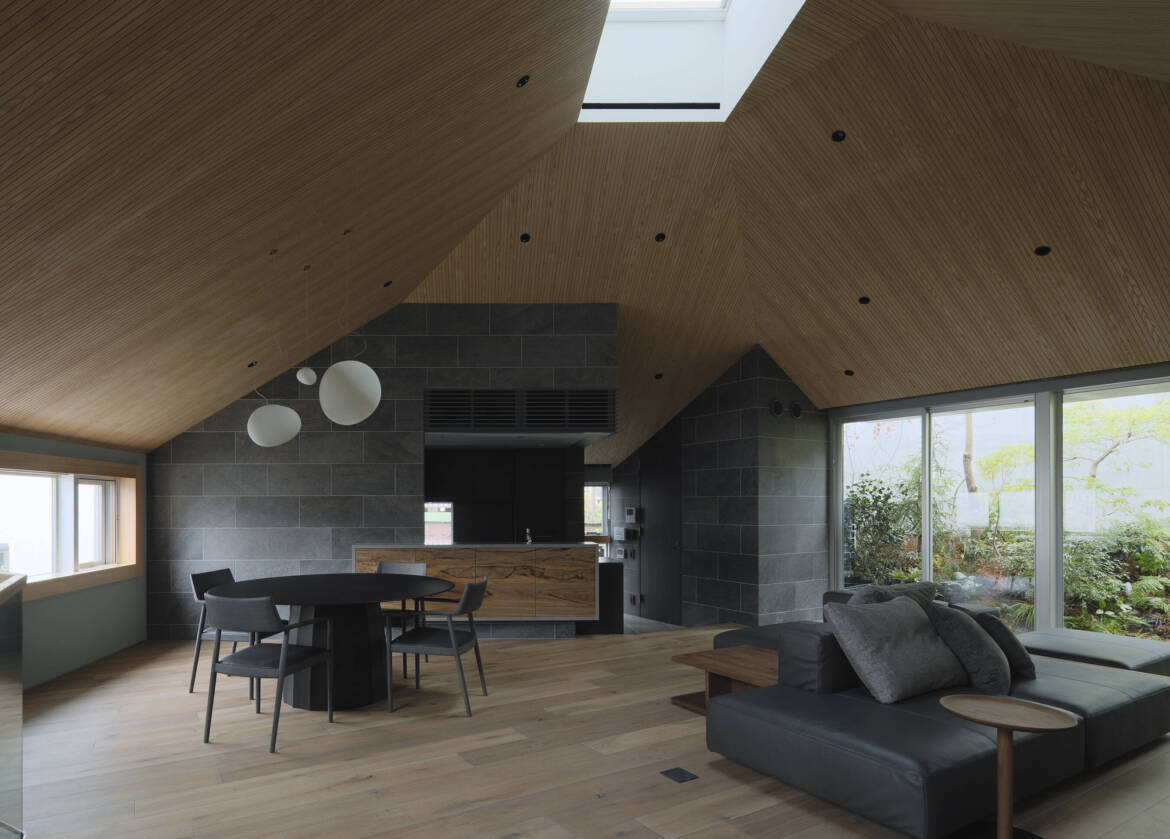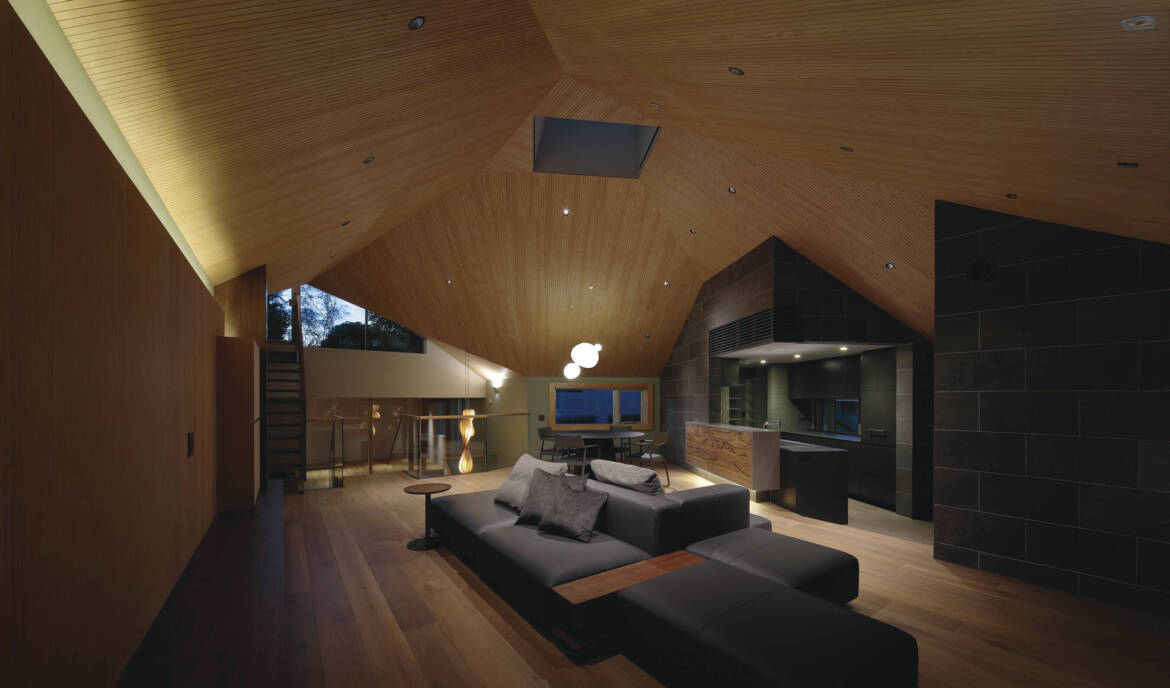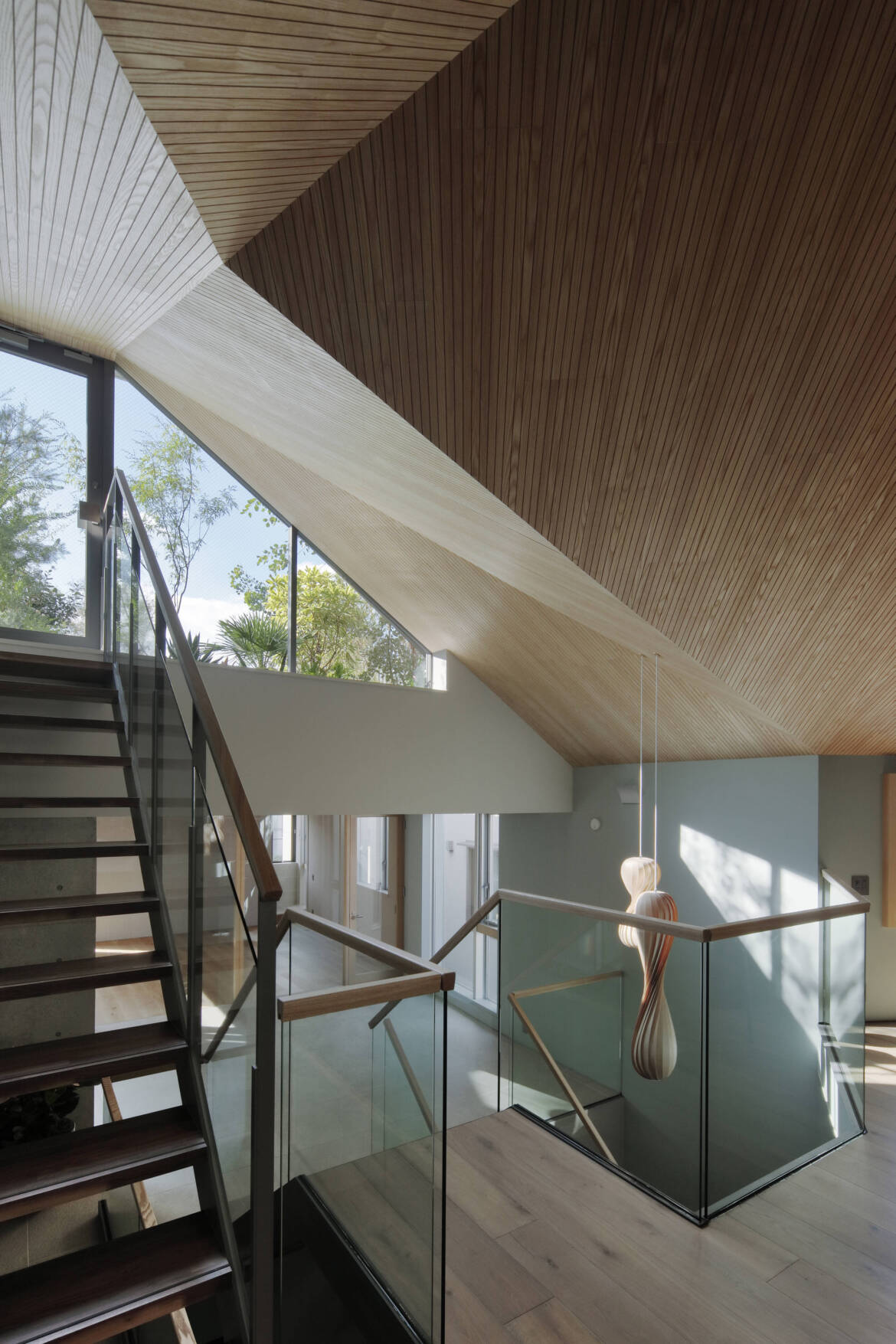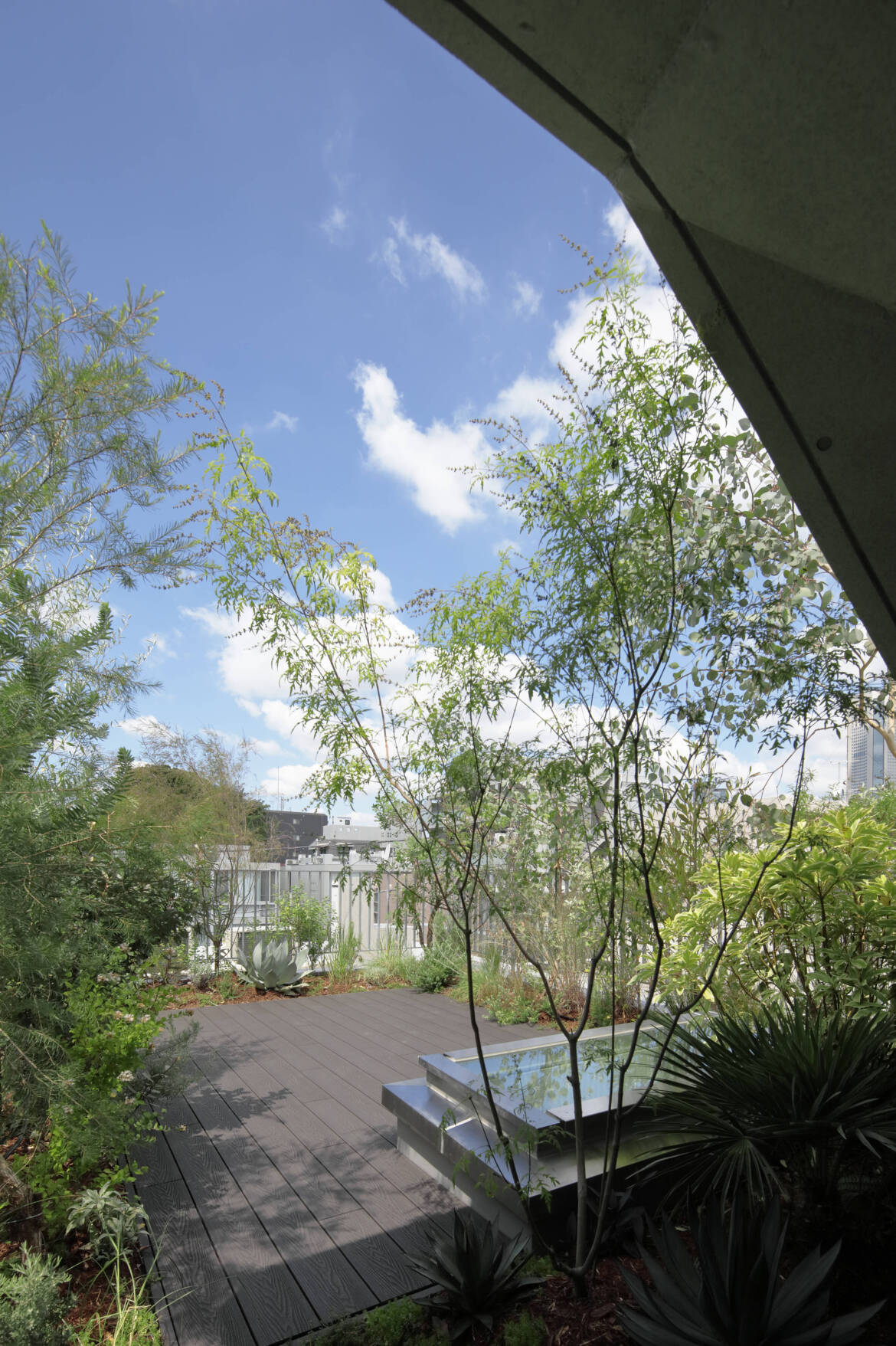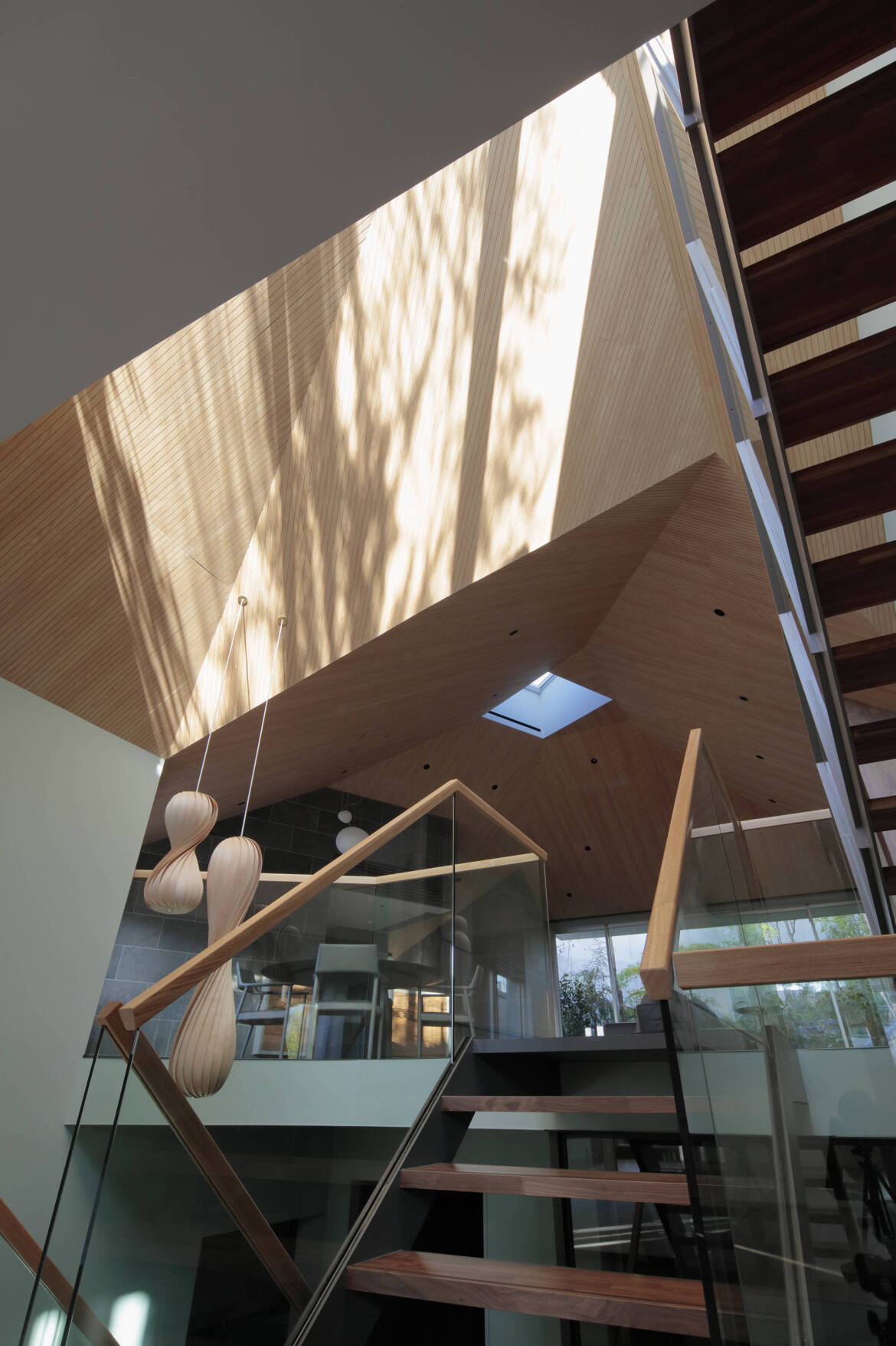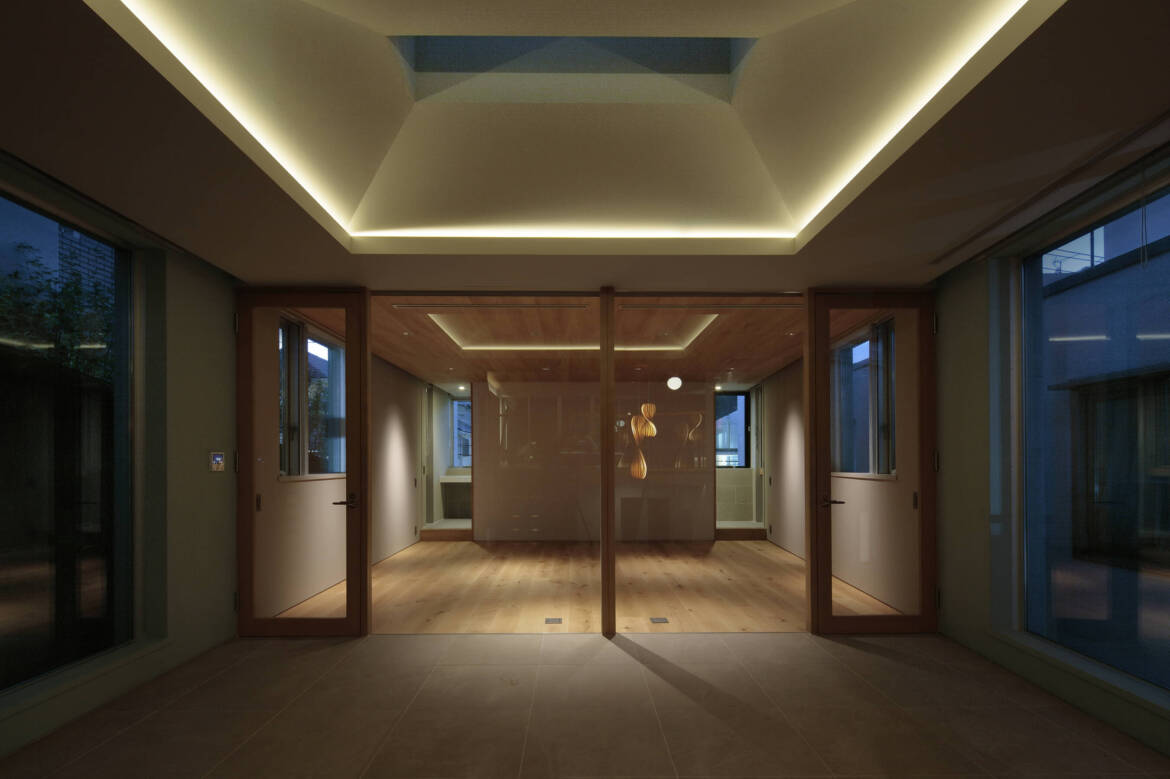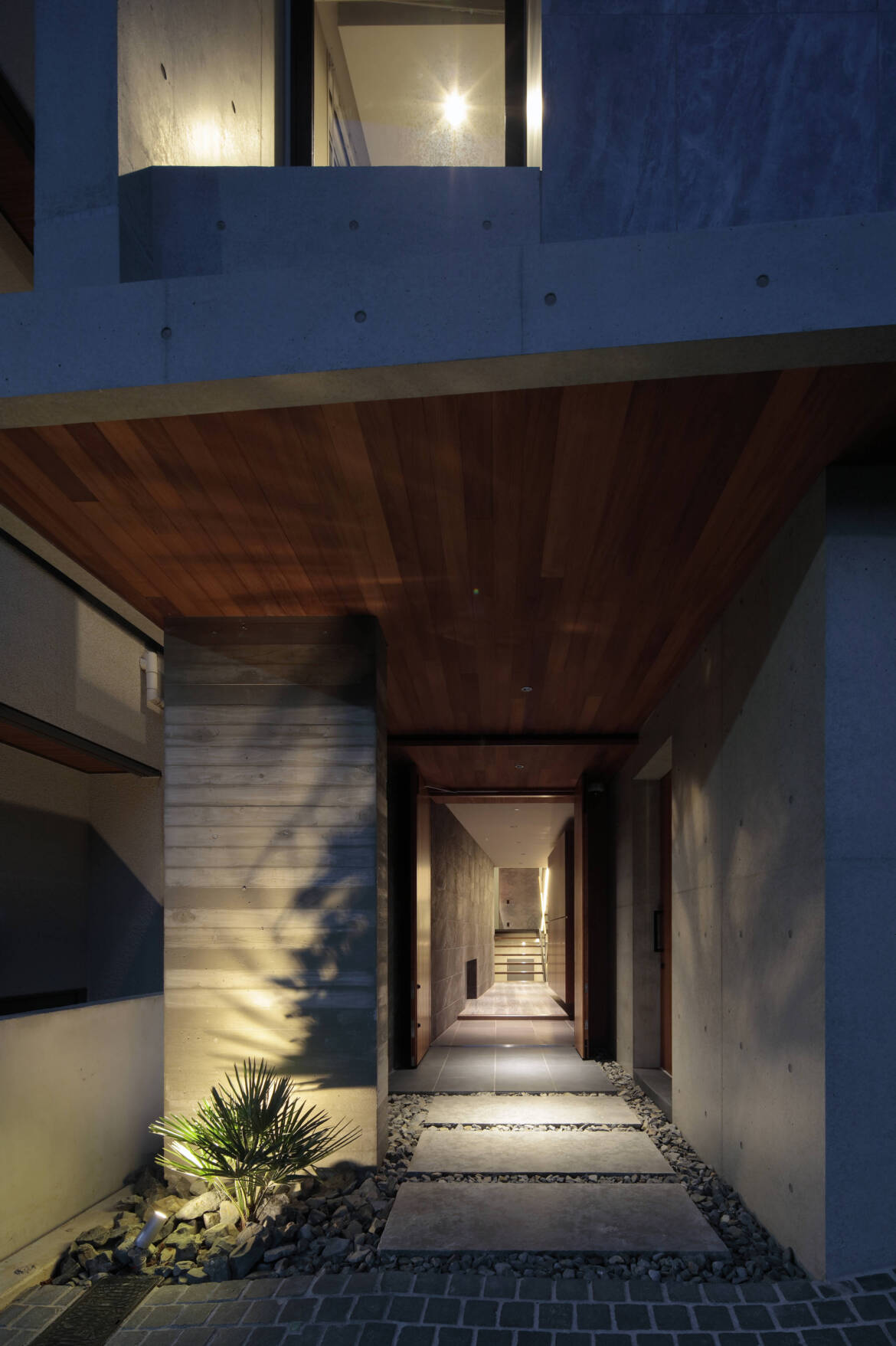Projects
The Sunken Retreat サンクン・リトリート
Information
Episode
敷地は都心部の閑静な住宅街にあり、北側の前面道路から南側奥に向かって細長く登りながら東側にも下がる傾斜地で高低差最大5m南側はアパートに見下ろされ、西隣には集合住宅の擁壁が敷地境界ギリギリに建っている。
クライアントからの要望は多くなかったが、複雑な斜線制限と平均地盤面など計画する上で厳しい条件が揃っている中で面積に関わる強い希望を満たす必要があった。
・できる限り閉塞感のない開放的な明るい快適な住まいにしたい。
・接道間口が狭いながらも2台の車を置けるようにする
・できるだけ面積を確保してほしい。
・音楽が聴ける落ち着いた空間がほしい。
–
–
Planning
面積を最大限確保するために地下を設けることになったが、最上階の2階以外の居室は地下に埋まることになる。そのため地下であることをマイナスのイメージとは捉えずに、自然の渓谷に習い、地下に落ち着いた詩的な光が降り注ぐような構成を採ることにした。
反対に最上階の2階は屋根の傾斜を工夫しプライバシーを確保しながらトップライトとハイサイドライトを設け、南側敷地の庭、北側屋上の庭園を設けることとで明るく風も視線も抜ける、自然に囲まれたツリーハウスのような開放感のある階となり、上階と地下で自然の谷のようなコントラストのある高低差をつけることにした。
–
◎渓谷のような階段ホール
斜面に沿わせてスキップさせることで、地下をつくるために搬出する土量を抑えながら、建設のし易さにも配慮した。全体で6つあるスキップした居室を切れ目のなく連続させ、その間を垂直に貫く高さ10mの階段吹き抜けを通して2階に設けたトップライトやハイサイドライトから自然光が地下に注ぎ光のグラデーションができる。
–
◎ツリーハウスのような開放感
解放案のあるリビングダイニングのドーム天井中心にトップライトを設け、連続する空間の熱環境の調節にも利用している。天井の傾斜はそのまま北側の屋上に向かって斜線に沿って登り空を見上げるハイサイドライトに複雑に繫がり光を反射する。
リビングのある敷地の奥側はアパートやマンションから見下ろされる関係にあるため、プライバシーを確保しながら抜けのある開放感を実現する為に、南側の庭に対しては軒を低く抑え傾斜した地形をそのまま法面の庭として残した。また最上階をガラスの仕切りが一部あるだけのワンフロアとすることで、長手方向へ視線が抜ける開放性を確保した。
–
–
Environment
3層の建物面積の半分が地中に埋まることから、地下から最上階、屋上までの環境の違いを積極的に活用しながら制御する計画とした。地下から最上階まで繋がる吹き抜けを循環する換気システムは、2階リビングのドーム天井のトップライト脇と地下の階段の最下段を吸入口として機械的にも送風し、夏と冬で逆転し同時に排気もできることで、心地よい温熱環境を作り出している。また地下の床下躯体に埋設された床暖房によってコンクリートに蓄熱することで、地下の湿度の問題と底冷えの解消を試みている。これらの複合的な方法によって連続する大きな空間に起こりがちな局所的な環境の変化を緩やかに制御している。
居住環境としての地中はネガティブ要素というよりは、昨今の猛暑の夏には涼しく一年を通して安定した環境である。最上階の窓から入る木漏れ日を地下から見上げると渓谷の底にいるような落ち着きを感じる。地下には明るい照明計画を施すというよりは、あえて面が自然に光っているような落ち着いた明るさを保ち、色彩計画も地下は暗めで最上階に向かうほど明るい色とマテリアルとグラデーションにすることで、より陰と陽を意識しつつどちらも魅力的な居場所として感じられるようにコントロールし、全体としてどこにいてもプライバシーを保ちつつ開放性や自然を感じられる家になった。
–
–
Episode
The site is located in a quiet residential neighborhood in the city center, with a narrow, sloping terrain that rises towards the rear of the lot while also descending to the east. The elevation difference is as much as 5 meters, with apartments overlooking the southern side, and a retaining wall of a collective housing structure built right at the boundary on the west side. Though the client had relatively few specific requests, there were stringent conditions such as complex zoning regulations and the need to meet area requirements, making the design challenging.
The key requests were as follows:
To create a spacious, bright, and comfortable living space that feels open and without a sense of enclosure.
・Despite the narrow frontage, accommodate two cars for parking.
・Maximize the usable area as much as possible.
・Provide a calm and peaceful space for listening to music.
–
–
Planning
To maximize the available area, a basement was included in the design. However, except for the top floor (second floor), all living spaces would be located underground. Rather than viewing the underground as negative, we drew inspiration from natural valleys and aimed to create a space where calm, poetic light would cascade into the basement.
Conversely, the second floor was designed with a sloping roof to maintain privacy while incorporating a combination of skylights and high side lights. The southern garden, as well as a rooftop garden on the northern side, were added to create an open, airy atmosphere, like a treehouse, where both natural light and ventilation could flow freely. This design concept establishes a contrast between the upper floors and the basement, creating a sense of height and depth akin to a natural valley.
Valley-like Staircase Hall
The staircase hall was designed to follow the slope of the site, allowing for a reduction in the amount of earth that would need to be excavated for the basement. This consideration also made the construction process more efficient. The six “skipped” living spaces are continuously connected without interruptions. Through a 10-meter high vertical stairwell, natural light from the top and side lights on the second floor gradually illuminates the basement, creating a beautiful gradient of light.
Treehouse-like Openness
The living-dining area, which has a dome ceiling, features a skylight at its center, helping to regulate the temperature of the continuous space. The ceiling slope naturally rises in alignment with the slanted site, leading to a high side light that reflects light. On the southern side, the area is overlooked by neighboring apartments, so we designed the space to maintain privacy while achieving an open, spacious feel. The eaves were kept low, and the sloped terrain was left as a terraced garden. Furthermore, the top floor was made into a single open floor with only partial glass partitions, which allows views to extend freely in the long direction, enhancing the openness.
–
–
Environment
Given that half of the three-story building is underground, we took advantage of the environmental differences from the basement to the rooftop and controlled these elements effectively. The ventilation system, which circulates through the atrium connecting the basement to the top floor, uses natural air intake from the bottom steps of the underground staircase and near the skylight on the second floor. The system can reverse airflow during summer and winter, promoting an optimal thermal environment. Additionally, underfloor heating in the basement, embedded in the concrete slab, absorbs heat to address the humidity and coldness of the underground space. These combined methods help regulate localized environmental variations in the large, continuous space.
Rather than considering the underground space as a negative element, it provides a cool, stable year-round environment, especially beneficial in the hot summers. Looking up from the basement toward the sunlight filtering through the top floor’s windows feels like being at the bottom of a valley, providing a sense of calm. The lighting plan for the basement was designed not to be overly bright but to maintain a natural, gentle glow. The colour scheme gradually shifts from darker tones in the basement to lighter hues and materials as you ascend to the top floor. This gradient effect brings both light and shadow into focus, making the entire house feel balanced between privacy and openness, with an emphasis on the natural environment.
-
- Status
- Completed 2024
-
- Category
- New Construction
-
- Location
- Tokyo, Japan
-
- Program
- Residence
-
- Structural Type
- reinforced concrete
-
- Architect
- FEDL
-
- Project Team
- Takanori Ihara, Satoshi Katagaata(Aether Studio), Asuka Kanazawa, Tomoko Ihara
-
- Structural Engineer
- Ken Nagasaka Engineering Network
-
- Landscape
- Ikegami
-
- Construction
- Eiko Kensetsu
-
- Photographer
- Koichi Torimura
